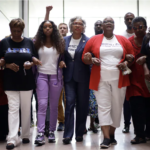By SHAHID ABDUL-KARIM
New Haven Register
NEW HAVEN, Conn. (AP) _ Sag is swag if you ask some young people.
For Trevor Smith, saggin’ pants are merely a fashion statement.
Others, however, worry that it perpetuates racial stereotypes, may have roots as a gay male signal and could lead to health complications based on the way it can force wearers to walk.
But Smith, 18, a student at Gateway Community College, said, “It’s just fashion for us. Everyone has a different look at it and some people don’t know how to go with the changing times.”
“We know the meaning of the pants saggin’ years ago; it’s changing now,” he said. “We don’t focus on what it meant back in the day or the negative, we wear it as part of our swag or expression.”
Opinions vary on the origin of the sagging pants movement.
Some contend that it sprang up because belts were not allowed in prison _ to prevent self-harm, while some believe blacks who were enslaved were denied belts for fear they would aid in escape.
“The saggin’ started in the prison where inmates couldn’t wear belts, but in jail culture things started to transcend,” said community activist Leonard Jahad, the state’s top New Haven probation supervisor,
“The left pant leg rolled up meant you’re in a certain gang and both pant legs rolled up meant something else,” Jahad said. “When pants are down like the kids wear on the streets, in prison, it means you are available to the next man for sexual activity.”
Smith, who’s also entertainment director of the youth development organization Ice the Beef, said he and his peers don’t view the sagging pants as a sexual signal, or anything more than a style choice.
“We’re not saggin’ our pants to be disrespectful. Nobody says anything when people wear short jean skirts; no one cares,” he said. “It’s no different when our mothers and grandmothers wear the big hats to church. It’s fashion for them and the sag is our fashion.”
Smith acknowledged that some of his peers who wear sagging pants go to the extreme.
“Some of us do take it to the max, but it’s not like it’s to the ankles,” Smith said.
“It’s part of black culture now, but whites and Puerto Ricans wear the sag, too,” he said.
Several white male youth who wear their pants sagging were interviewed for the story. All declined be identified.
However, they agreed it’s purely a fashion expression and a way to be connected to their black peers.
Jason Jacobs, 15, who has been wearing the sagging style since he was 9, said he wore it for the wrong reasons.
“When I first started doing it, I did it so I could stuff things into my pants, now it’s a trend everyone does,” Jason said.
“I don’t do it all the time like I use to; it was a big with me at one point,” he said. “I’m trying to stop the sag, because I want to be different now.”
Jason said black youth started the trend and believes “white boys have picked up on it to be like us.”
City resident Ronald Huggins, 22, who does not agree with the sagging fashion, said he believes the black community is the hub for style and fashion for other ethnic groups.
“We’re the brainchild for a lot of things and if we only realized the influence and the amount of power we have to produce positive things, we’d be setting records all over the world,” said Huggins, a Southern Connecticut State University graduate who aspires to be mayor of New Haven.
“If we can just get ourselves together, we can affect the nation and generations to come,” he said.
The fashion has created a way of life for some who identify with the hip-hop community.
New Haven hip-hop and graffiti artist Dooley-O Jackson said hip-hop introduced the style to mainstream society because youth had no other options to express themselves.
“(Some) adults wear suits and kids wore tight shorts, so hip-hop broke the standard rules of dressing,” said Jackson, 44, who started rapping in the late 1980s.
Differentiating rap music from hip-hop culture, Jackson said, “Rap never had its own fashion, its always been hip-hop.
“Pants hanging off your bottom is something that came from jail,” he said. “When hip hop at its worst had no new swag, except jailhouse rock clothing, the youth adopted it.”
According to hiphop-network.com, in the early 1970s the musical genre was born in the crime-ridden neighborhoods of the South Bronx.
Fashion statement or not, some towns across the country have decided sag is not swag. In New Jersey, two towns have passed ordinances banning sagging pants, and other towns have considered or adopted similar measures.
Penns Grove and Wildwood are issuing fines of $25 on first offense.
On further offenses, fines could climb to $1,000, as well as potential community service hours.
But state Sen. Gary Holder-Winfield, D-New Haven, said creating a law on the issue is a waste of time.
“No one in the House or Senate has raised the issue. Different cities in the state talked about it last year, but nothing came from it,” said Holder-Winfield.
“Personally, I think it’s a sloppy fashion and adds to the negative perception of black youth; it needs to be done away with.” he said.
Jahad said from a law enforcement perspective, he sees it as similar to the broken window theory _ which posits that addressing issues such as vandalism in neighborhoods helps address larger issues.
“It’s like a quality-of-life crime, it’s seen as if your pants are down, you’re not motivated, you don’t have a job and don’t care about yourself,” Jahad said.
“This is a community accountability issue, but when we can’t police ourselves, law enforcement steps in,” he said.
Jahad believes race does play a factor when it comes to law enforcement stereotypes.
“Skateboarders and hipsters wear their pants saggy, but they’re not seen as anti-establishment,” he said. “For our kids, law enforcement is looking at it like it’s criminal.”
Zebra Hip Hop Sportswear owner Yaser Elhilo said the trend is changing.
“Young people from the age of 15-29 are now looking for fit and slim jeans,” said Elhilo, whose store is located at 344 Whalley Ave.
“It’s the over-30 group that are looking for the loose saggy jeans for a more comfortable feel,” said Elhilo, whose customers are mainly Latino and black.
In terms of fit, some in the health field say structural and biomechanical modifications that bring the sag can cause nerve damage and alter the wearer’s gait.
“Its altering balance and altering the way you load your weight; it’s never straight-legged,” said Eileen M. Denny, of Denny Chiropractic and Acupuncture in Hamden.
“When pants sag, you’re rotating the legs inward at the knees and turning feet outward to keep balance, which create poor posture,” said Denny, whose office is located at 2842 Old Dixwell Ave.
Denny said long-term effects can include knee alignment and foot issues.
“Anytime you improperly load your spine or lower back, you run a greater risk of arthritis,” said Denny. “When weight is put on the front of the thigh, pain will go down the thigh causing pressure on the nerves.”
Among other factors that surround the culture of sagging pants is what the word saggin’ spells in reverse.
Smith said he is aware of the word in reverse, but it is no longer a negative in his vocabulary. If used in acronym form, the word now means “Now I’m Getting Goals Accomplished…,” Smith said.
“People fought for the word to be removed and it’s not going anywhere, so why not take it from a negative into a positive,” he said.
Although the word has pejorative connotation, Smith said in 2014 it’s not often used as an insult.
“Nobody uses it to insult people anymore, and the people that do are ignorant,” he said.
Further, Quinnipiac Associate Professor of Journalism Richard Hanley said political operatives use certain other words instead of directly pejorative words.
“I don’t know if (saggin’ in reverse is) an accident of vocabulary or something that holds meaning, but I don’t think young black men understand the word in reverse,” Hanley said.
Hanley said when politicians use words in a pejorative sense, they know what they’re alluding to.
Some racial code words include welfare, food stamps, inner-city and crime.
“They signal something, maybe not a direct racist attitude, but they summon racist feelings,” he said. “The polls show that; that’s why it’s used as a political instrument, especially when it was unacceptable to use the n-word.”
Smith said adults may not like the fashion but “I’m sure they had their style and fashion when they were young, too.”











